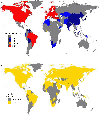The 18th International HLA & Immunogenetics workshop project report: Creating fully representative MHC reference haplotypes
- PMID: 38923286
- PMCID: PMC11210686
- DOI: 10.1111/tan.15568
The 18th International HLA & Immunogenetics workshop project report: Creating fully representative MHC reference haplotypes
Erratum in
-
Correction to "The 18th International HLA & Immunogenetics workshop project report: Creating fully representative MHC reference haplotypes".HLA. 2024 Jul;104(1):e15615. doi: 10.1111/tan.15615. HLA. 2024. PMID: 39056452 No abstract available.
Abstract
A fundamental endeavor of the International Histocompatibility and Immunogenetics Workshop (IHIW) was assembling a collection of DNA samples homozygous through the MHC genomic region. This collection proved invaluable for assay development in the histocompatibility and immunogenetics field, for generating the human reference genome, and furthered our understanding of MHC diversity. Defined by their HLA-A, -B, -C and -DRB1 alleles, the combined frequency of the haplotypes from these individuals is ~20% in Europe. Thus, a significant proportion of MHC haplotypes, both common and rare throughout the world, and including many associated with disease, are not yet represented. In this workshop component, we are collecting the next generation of MHC-homozygous samples, to expand, diversify and modernize this critical community resource that has been foundational to the field. We asked laboratories worldwide to identify samples homozygous through all HLA class I and/or HLA class II genes, or through whole-genome SNP genotyping or sequencing, to have extensive homozygosity tracts within the MHC region. The focus is non-Europeans or those having HLA haplotypes less common in Europeans. Through this effort, we have obtained samples from 537 individuals representing 294 distinct haplotypes, as determined by their HLA class I and II alleles, and an additional 50 haplotypes distinct in HLA class I or II alleles. Although we have expanded the diversity, many populations remain underrepresented, particularly from Africa, and we encourage further participation. The data will serve as a resource for investigators seeking to characterize variation across the MHC genomic region for disease and population studies.
Keywords: HLA; IHIW; MHC; ancestry; assembly; ethnicity; homozygous; long‐read; reference haplotype; sequencing; short‐read.
Conflict of interest statement
Conflicts of Interest
The authors declare no conflicts of interest.
Figures


References
-
- Parham P, Ohta T. Population biology of antigen presentation by MHC class I molecules. Science. 1996;272(5258):67–74. - PubMed
Publication types
MeSH terms
Substances
Grants and funding
LinkOut - more resources
Full Text Sources
Research Materials

